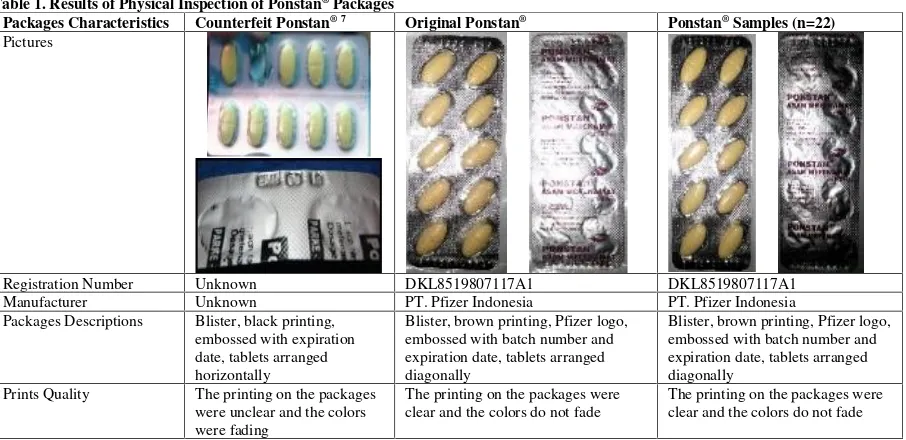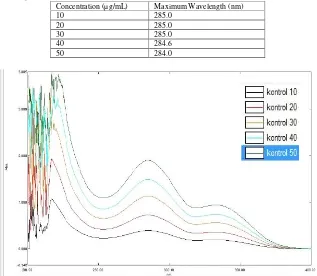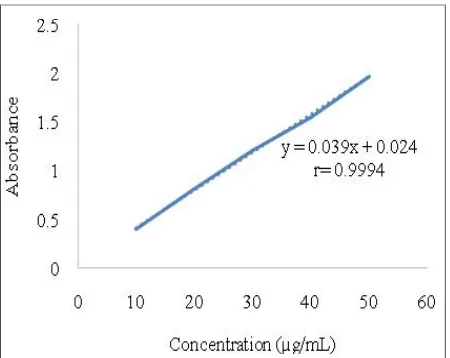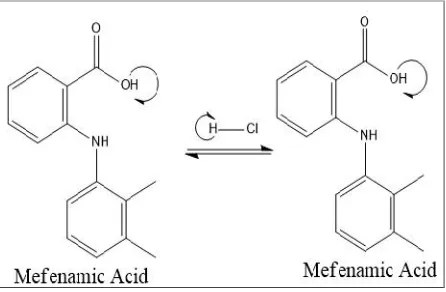ISSN
0974-3618 (Print)
www.rjptonline.org
0974-360X (Online)
RESEARCH ARTICLE
Post Marketing Study of Ponstan
®500 mg Tablet under Suspicion as
Counterfeit Drug at Pharmacies
Asri Rachmadi
1, Diana Lyrawati
2*, Adeltrudis Adelsa Danimayostu
31Pharmacy Study Program, Faculty of Medicine, Brawijaya University, Malang, Indonesia 2Department of Clinical Pharmacy, Faculty of Medicine, Brawijaya University, Malang, Indonesia
3Department of Pharmaceutics, Faculty of Medicine, Brawijaya University, Malang, Indonesia
*Corresponding Author E-mail:diana.l@ub.ac.id; eldi_7_98@yahoo.com; diana.lyrawati@gmail.com
ABSTRACT:
Ponstan® (Mefenamic Acid 500 mg) is one of a few commonly counterfeited drugs in Indonesia. Drug
counterfeiting would adversely affect consumers in terms of finances and health. Local health authority rarely conducted market inspection to address such problem. This study was conducted to determine whether Ponstan®
sold at pharmacies in the vicinity of public hospital were counterfeit drugs, based on tablets physical characteristics and active substance contents with regards of the Pharmacopeia Indonesia 4th Edition
requirements. This study used Ponstan® sampled from pharmacies within 1 kilometer radius of Class A or B
public hospitals in Malang. The packages and tablets were physically inspected, and mefenamic acid assayed by using spectrophotometric method at 285 nm. All of the samples showed similar physical characteristics when compared to the original Ponstan®. Of total 66 tablets collected from 22 pharmacies, mefenamic acid contents
were ranging from 94.58% to 111.72% of that listed on their labels, with 3.03% (2/66) contained more than 110%. It can be concluded that 96.97% (64/66) of Ponstan®tablets collected from sampled pharmacies meet the
requirements of Pharmacopeia Indonesia 4th Edition, whereas the other 3.03% belong to “not conformed
product” during quality control inspection.
KEYWORDS:
Ponstan®, counterfeit, pharmacies, hospital, spectrophotometryReceived on 10.04.2017 Modified on 15.06.2017 Accepted on 22.06.2017 © RJPT All right reserved
INTRODUCTION:
Drugs are one of key factors for health, however, regarded as expensive products1. Drugs should have
good quality, to ensure their desired therapeutic effects. Counterfeit drugs whether over the counter or prescription only drugs were found and sold in markets2.
In 2013, National Agency of Drugs and Foods Controls found 13 suspected counterfeit drugs3.
High demand of the drugs, combined with expensive price, may contribute to flourishing counterfeited drugs5.
During 1999 to 2006 at least eight cases of Ponstan®
counterfeiting has been reported in Indonesia6. At the
end of 2013, at least 1.1 billion tablets of counterfeited Ponstan® were discovered ready for distribution to
various pharmacies, clinics, and drug stores7. Ponstan®
contains mefenamic acid, which functions as analgesic and anti-inflammatory drug, widely used to treat headache or toothache. Ponstan®counterfeiting were also
reported in Columbia8. According to ‘Reportase
Investigasi’ (Investigation Reports), a TV Program that broadcasted via Trans TV Indonesia on January 3rd2015,
some irresponsible parties collected drugs remains that should have been destroyed by the hospitals or discarded by patients and resold those to gain profits9.
Indonesian hospitals are grouped to classes based on facilities and service capabilities into Class A, B, C and D (A is the most complete facilities and services and higher number of beds). Distribution facilities of pharmaceuticals monitored by the government among others are large pharmacy companies, pharmacies, and drug stores, which are more than 33,000 nationwide 10.
Surrounding hospitals are usually many private pharmacies run their business catering drugs for patients. Close monitoring/site-inspections of drugs distribution is currently not adequate due to disparity and limited small town in East Java Province, Indonesia. Drugs were assessed based on physical appearances and active ingredient contents according to requirements of the Pharmacopeia Indonesia 4th Edition. In this study, we
also developed and optimized a simple method to facilitate determination of mefenamic acid content of the drug samples.
MATERIALS AND METHODS:
Tools:
Spectrophotometer UV-Vis Shimadzu® UV 1800 was
used for spectral instrument with 1 cm quartz cuvette, analytic scale Unibloc Shimadzu® type AUW220,
Orbital Shaker Innova 2000/2050 Digital Platform Shaker, Whatman No.42 filter paper, and other glassware.
MATERIALS:
Pharmaceutical Grade Mefenamic Acid and NaOH (Sigma), original Ponstan® obtained from official
pharmaceutical supplier.
Samples:
Ponstan® tablets purposively were sampled from 22
pharmacies within a 1 kilometer of type A and B public hospitals in Malang. Pharmacies sampled were pharmacies not owned by the manufacturer of Ponstan®.
Ponstan®tablets should not be expired.
Standard Preparation:
A stock standard solution equivalent to 5mg/mL was prepared by dissolving 500 mg pure mefenamic acid into 0.1 M NaOH and diluting to 100 ml calibrated flask with 0.1 M NaOH. Then the solution was diluted to get 10, 20, 30, 40 and 50µg/mL concentration.10
Control Solution Preparation:
Ponstan®control solution equivalent to 5000µg/mL was
prepared by grounding one tablet of original Ponstan®
into fine powder and transferred into 100 ml volumetric flask with 60 ml of 0.1 M NaOH. The content was shaken for 15-20 minutes, dilute to volume with 0.1 M NaOH, and filtered using a Whatman No.42 filter paper. Firs 10 ml portion of filtrate was discarded and subsequent portion were subjected to analysis. Then the solution was diluted to get 10, 20, 30, 40 and 50µg/mL concentration.
Determination of Maximum Wavelength:
Standard solution and Ponstan® control solution with
different concentration (10, 20, 30, 40 and 50 µg/mL) were scanned between 200-400 nm against blank which shows the maximum absorbance at 285 nm.
Sample Preparation:
Samples were prepared by grounding one tablet of Ponstan® sample into fine powder and transferred into
100 ml volumetric flask with 60 ml of 0.1 M NaOH. The content was shaken for 15-20 minutes, dilute to volume with 0.1 M NaOH, and filtered using a Whatman No.42 filter paper. First 10 ml portion of filtrate was discarded and subsequent portion were subjected to analysis. Then 1 mL was taken from the solution and diluted into 100 mL volumetric flask with NaOH 0.1 M11.
RESULTS:
Packages Appearance of Ponstan:®
In terms of packages appearance, 100% samples showed packages appearances that correspond to the original Ponstan®tablets (Table 1). However, there were 13.63%
Table 1. Results of Physical Inspection of Ponstan®Packages
Packages Characteristics Counterfeit Ponstan® 7 Original Ponstan® Ponstan®Samples (n=22) Pictures
Registration Number Unknown DKL8519807117A1 DKL8519807117A1
Manufacturer Unknown PT. Pfizer Indonesia PT. Pfizer Indonesia
Packages Descriptions Blister, black printing,
embossed with expiration date, tablets arranged horizontally
Blister, brown printing, Pfizer logo, embossed with batch number and expiration date, tablets arranged diagonally
Blister, brown printing, Pfizer logo, embossed with batch number and expiration date, tablets arranged diagonally
Prints Quality The printing on the packages
were unclear and the colors were fading
The printing on the packages were clear and the colors do not fade
The printing on the packages were clear and the colors do not fade
Tablets Appearance of Ponstan®
In terms of tablet appearance, 100% samples had appearances that correspond to the original Ponstan ®
tablets (Table 2).
Determination of Mefenamic Acid Maximum Wavelength
Determination of mefenamic acid maximum wavelength were performed at different concentrations of standard solution (10, 20, 30, 40, and 50µg/mL) and scanned between 200-400 nm against blank (Table 3, Figure 1). Determination of the wavelength of original Ponstan®
control solutions were also prepared with concentration equivalent to 10, 20, 30, 40, and 50µg/mL mefenamic acid (Table 4, Figure 2).
Table 2. Results of Physical Inspection of Ponstan®Tablets
Packages Characteristics Counterfeit Ponstan® 7 Original Ponstan® Ponstan®Samples (n=22)
Pictures
Tablet Colors Dark Yellow Light Yellow Light Yellow
Tablet Descriptions Do not have any emboss Unchipped edge, smooth surface, has
emboss P-D
Unchipped edge, smooth surface, has emboss P-D
Tablets Dimension Unknown Length 1.94 cm
Width 0.98 cm Thickness 0.66 cm
Length 1.94 cm Width 0.98 cm Thickness 0.66 cm
Table 3. Maximum Wavelength of Mefenamic Acid
Concentration (µg/mL) Maximum Wavelength (nm)
10 285.2
20 285.0
Figure 1. Mefenamic Acid Wavelength Spectra
Table 4. Maximum Wavelength of Ponstan® Control
Concentration (µg/mL) Maximum Wavelength (nm)
10 285.0
20 285.0
30 285.0
40 284.6
50 284.0
Determination of Standard Calibration Curve:
Determination of Standard Curve linearity of mefenamic acid in NaOH 0.1 M with different concentrations 10, 20, 30, 40, and 50µg/mL were scanned at maximum wavelength of 285 nm (Figure 3).
Figure 3. Standard (Mefenamic Acid) Calibration Curve in NaOH at 285 nm
The standard calibration curve showed linear relationship between concentration and the absorbance with correlation coefficient 0.9994 and equation Y= 0.039X + 0.024 (Figure 3). In addition, the calculation of molar absorptivity obtained from the standard calibration curve was 9627.47 M-1cm-1.
Determination of Ponstan® control calibration curve was also be made to be used as a comparison with concentration equivalent to 10, 20, 30, 40, and 50 µg/mL at 285 nm (Figure 4).
Figure 4. Ponstan® Control Calibration Curve in NaOH at 285 nm
with correlation coefficient 0.9997 and equation Y= 0.0378X +0.0024 (Figure 4). In addition, the calculation of molar absorptivity obtained from the standard calibration curve was 9096.63 M-1cm-1.
Based on the results of both calibration curve, the Ponstan®control calibration curve was used to determine
the value of mefenamic acid contents because it has higher value of correlation coefficient.
Mefenamic Acid Assay:
Based on mefenamic acid content assays, 66 tablets of 22 pharmacies were analyzed and mefenamic acid was found in every samples, ranging from 94.58% to 111.72% from that listed on the label: 6.06% (n=4) contained between 90% to 100% per tablet, 90.91% (n=60) contained between 100% to 110% per tablet, and the remaining 3.03% (n=2) contained more than 110% per tablet.
Table 5. Mefenamic Acid Contents from Ponstan®Tablets Samples
Code
Replication 1 (%)
Replication 2 (%)
Replication 3 (%)
A 103.37 108.29 106.49
B 106.80 110.08* 99.34
C 94.58 100.93 104.48
D 98.29 107.02 100.19
E 99.82 103.31 100.88
F 104.16 104.42 105.59
G 103.37 101.57 102.10
H 105.80 107.86 109.03
I 106.12 108.13 108.02
J 107.44 105.85 108.92
K 104.26 104.05 107.17
L 108.07 107.49 104.90
M 103.58 103.10 105.27
N 107.54 107.65 111.72*
O 108.60 109.24 107.49
P 106.75 104.95 105.53
Q 100.40 106.70 107.86
R 104.53 103.89 105.16
S 105.75 107.39 106.22
T 103.84 103.63 105.38
U 106.22 109.45 107.23
V 105.53 106.80 107.81
Notes: *Indicates the sample does not meet the requirement of
Indonesia Pharmacopeia 4thEdition
Our data shows 64 tablets from 22 pharmacies in the vicinity of type A or B public hospitals in Malang contain mefenamic acid that meet the requirements of Indonesia Pharmacopeia 4th Edition that states every
Ponstan® must contain mefenamic acid not less than
90.0% and not more than 110.0% of the amount listed on the label.
DISCUSSION:
requirements are 22 pharmacies. The packages and tablets from all samples were inspected, and active substances were analyzed using spectrophotometric method.
Based on the physical inspection of Ponstan®packages,
it was found that all samples registration number was DKL8519807117A1 with PT Pfizer Indonesia as its manufacturer as indicated in original packages of Ponstan®or on data obtained from National Agency of
Drugs and Foods Controls. This proves that the entire samples were the same as the original, although there are three samples that had a slightly bent blister condition, the possibility of this was due to the poor drug handling during distribution or storage at pharmacy so when the drug was in the hands of consumers, it has already in an inappropriate conditions (Table 1).
Moreover, in comparison to the original, counterfeit Ponstan®has black printing and it has less clear printing
quality than the original. In addition to the counterfeit Ponstan®, the tablets were arranged horizontally which
should be arranged diagonally as the original Ponstan®
(Table 1).
In terms of physical appearance of the tablets, when compared to the original Ponstan®tablets 100% (n=22)
samples had the same characteristic as the original Ponstan® (Table 2). It is evident that the counterfeit
Ponstan® had the dark yellow color instead of light
yellow color as the original. In addition, the counterfeit Ponstan®did not have any P-D emboss on the tablets, a
signature to indicate that the tablets were original Ponstan®.
From the two categories of packaging and tablets of Ponstan®, in terms of physical appearances it can be
concluded that the entire samples can be said to be original product (Table 1, Table 2).
Based on Regulation of Minister of Health number 242 year 2000, there are a lot of kind of counterfeit drugs. Unauthorized counterfeited drugs might be detected easily by looking at the registration number and the manufacturer of the products. Counterfeit drugs can also be identified following active substances assay. Such assay, however, is rarely used by our local authorities, especially if it involves expensive reagents and equipments, due to constraint funding.
Spectrophotometry can be used to identify the levels of active substance in a drug. The spectrophotometric method is relatively simple, sensitive, practical, accurate, precise, and inexpensive. The substance to be measured should be dissolved into clear solution, no sediments and preferably chromophoric by nature12.
Our method was a modification from Singh et al (2011) which reported used 0,1 M HCl solvent11. Mefenamic
acid is a weak acid with pKa of 4.2, whereas HCl has pH of 1. Weak acid cannot be dissolved in a solution with a pH below its pKa, ionization will not occur (Figure 5)13.
Figure 5. Mefenamic Acid and HCl Reaction
Therefore, in our assays, 0.1 M NaOH was used. Mefenamic acid can be diluted with 0.1M NaOH solution due to reaction between hydrogen ions derived from acids (mefenamic acid) with hydroxide ions derived from bases (NaOH) to form water and mefenamic salts, which is sodium mefenamate (Figure 6)14.
Figure 6. Mefenamic Acid and NaOH Reaction
In its salt form, the solubility of mefenamic acid increased as much as 42-fold compared to the acid form when dissolved in the same medium15.
The standard calibration curve of pure mefenamic acid solution showed correlation coefficient 0.9994 and Y= 0.039X + 0.024 (Figure 3), whereas Ponstan® control calibration curve has correlation coefficient 0.9997 and Y= 0.0378X +0.0024 (Figure 4). Based on the calculation of molar absorptivity obtained from standard curve and Ponstan® control curve, it was found that the standard molar absorptivity was 9627,47 M-1cm-1 and
Ponstan® control molar absorptivity was 9096,63 M -1cm-1. The molar absorptivity value between 1000
-10000 M-1cm-1indicates the presence of aromatic ring16
which corresponds with the two aromatic rings of benzene in mefenamic acid chemical structure. With such good conformity results, we decided to use Ponstan® control calibration curve to determine the mefenamic acid contents of all tablet samples.
A total number of 96.97% or 64 out of 66 tablets from 22 pharmacies in the vicinity of type B public hospital or higher in Malang contain mefenamic acid that meet the requirements of Indonesia Pharmacopeia 4thEdition that
is not less than 90.0% and not more than 110.0% of the amount listed on the label, with 3.03% (n=2) samples does not meet the requirements of Indonesia Pharmacopeia 4th Edition. We did not determine other
active ingredients.
The 2 out of 66 Ponstan®tablets which not conform to
Indonesia Pharmacopeia 4th Edition requirements may
not be counterfeited products because the other two tablets from the same package met the Indonesia Pharmacopeia 4th Edition requirements. Manufacturing
and/or quality control processes may need improvement to avoid tablet products containing too high active substance which may harm consumer by raising the risk of adverse effects.
Other than active substances, drug excipients may also be counterfeited, therefore it is necessary to check other substance that can causes health problems that may be contained in suspected counterfeit drugs. Excipients affect the physical quality and pharmacokinetics of the drugs, e.g. hardness, friability, disintegration or dissolution rate of drugs, leading to less than expected or even unwanted effects.
CONCLUSIONS:
Careful visual inspection of drug appearance, e.g. printed drug registration number, name of drug manufacturers, drug packaging, and the quality of the printing itself may suffice to distinguish original vs counterfeit drugs. A simple and inexpensive method to determine the mefenamic acid content in a Ponstan®tablet could also
be performed by local authorities to ensure its
demonstrated that 100% samples with physical appearances that correspond to the original, 96.97% (64 out of 66) Ponstan®tablets obtained from 22 pharmacies,
in the vicinity of Class A or B public hospitals in Malang, met the requirements of Pharmacopeia Indonesia 4th Edition as of the original Ponstan®. Thus,
there was no counterfeited Ponstan® tablet detected in
sampled Malang pharmacies.
CONFLICT OF INTEREST:
The authors declare no conflict of interest.REFERENCES:
1. Winda. Perbandingan Mutu Tablet Metronidazol Generik dengan
Merek Dagang Secara in Vitro. Medan: Universitas Sumatera Utara; 2009.
2. Karlina N. Optimalisasi Pengawasan Toko Obat Oleh Bidang
Pemeriksaan dan Penyidikan Balai Besar Pengawas Obat dan Makanan Bandung. Jatinangor: Universitas Padjadjaran; 2008.
3. Herman. Daftar 13 Obat yang Diduga Palsu. 2014.
http://www.beritasatu.com/
kesehatan/159377-daftar-13-obat-yang-diduga-palsu.html Accessed 10 October 2014.
4. Yustisia D. Pemalsuan Obat-Obatan dan Putusan Hakim
Mengenai Tindak Pidana Pemalsuan Obat. Yogyakarta: Universitas Islam Indonesia; 2010.
5. Pramudiarja AY. Ponstan dan Obat Malaria Fansidar Paling
Sering Dipalsukan. 2012. Accessed 11 October 2014.
6. Akib HRT. Combating Counterfeit Drugs in Indonesia: General
Approaches and Strategic Action. 2007.
www.powershow.com/view/396fc-m2jiy/
8. Pfizer. Counterfeit Medicines: A Clear and Present Danger. 2007.
9. Riyadi MA. Reportase Investigasi. [Television Broadcast].
Jakarta: Trans TV; 2015.
10. RI MoH. Indonesia Health Profile 2013. Ministry of Health
Republic of Indonesia; 2014.
11. Singh H, Kumar R, Singh P. Development of UV
Spectrophotometric Method for Estimation of Mefenamic Acid in Bulk and Pharmaceutical Dosage Forms International Journal of Pharmacy and Pharmaceutical Sciences. 2011;3(2):237-8.
12. Wiryawan A, Retnowati R, Sabarudin A. Kimia Analitik Untuk
SMK. Jakarta Direktorat Pembinaan Sekolah Menengah Kejuruan; 2008.
13. Watts J, Moffat AC, Osselton MD, Widdop B. Clarke’s Analysis
of Drugs and Poisons. 4 ed. London Pharmaceutical Press; 2011.
14. Waldini TK. Penetapan Kadar Asam Mefenamat dalam Sediaan
Kaplet Secara Titrasi Alkalimetri. Medan: Universitas Sumatera Utara; 2013.
15. Bani-Jaber A, Hamdan I, Al-Khalidi B. Sodium Mefenamate as a
Solution for the Formulation and Dissolution Problems of Mefenamic Acid. Chemical and Pharmaceutical Bulletin. 2007; 55(8):1136-40.
16. Pavia D, Lampman G, Kriz G, Vyvyan J. Introduction to



